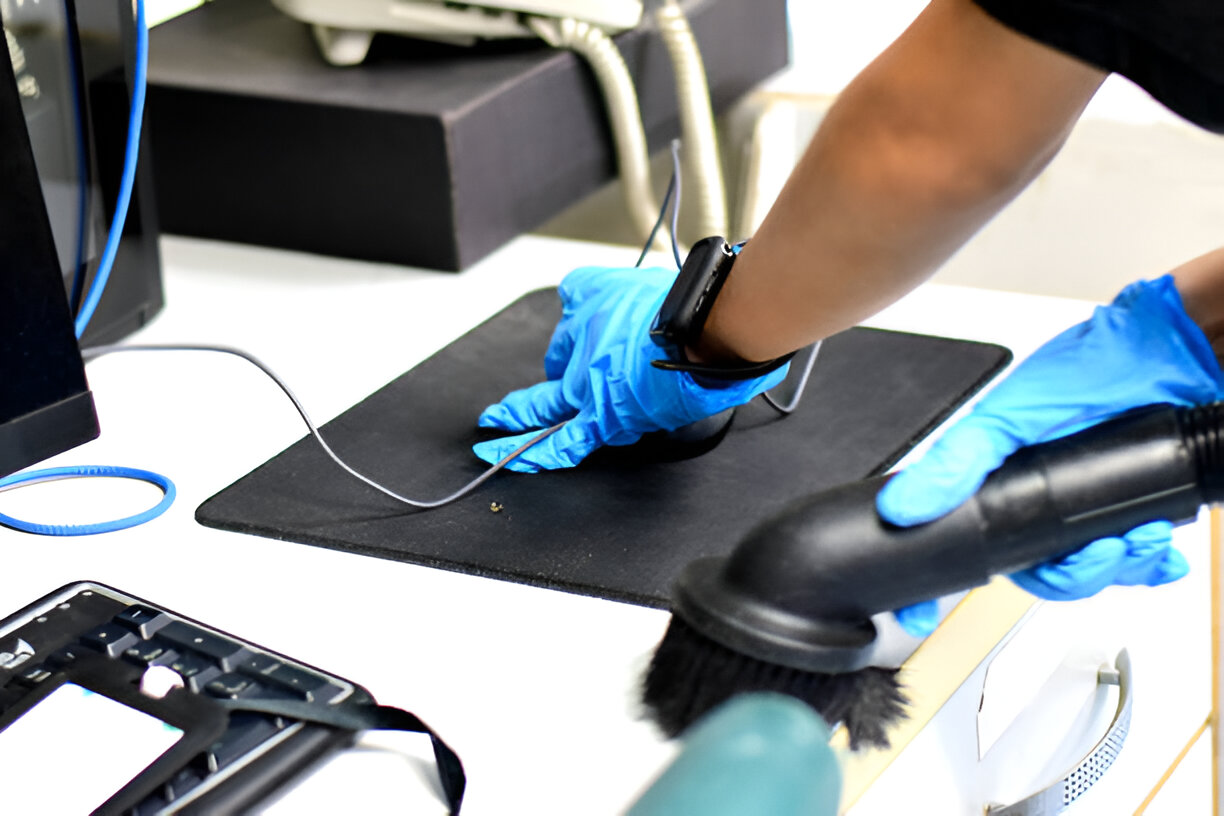


ESD Consultation provides expert guidance on identifying, preventing, and mitigating electrostatic discharge (ESD) risks. It includes workplace assessments, ESD control measures, compliance with industry standards, and employee training to protect sensitive electronics and ensure a safe, static-free environment.

ESD Floor Qualification ensures flooring meets industry standards for electrostatic discharge (ESD) control. It involves testing surface resistance, charge decay, and electrostatic properties to protect sensitive equipment and maintain safety in industries like electronics manufacturing, cleanrooms, and healthcare.

ESD S20.20 Facility Certification ensures that a facility complies with ANSI/ESD S20.20 standards for electrostatic discharge (ESD) control. It involves evaluating ESD protection measures, grounding systems, and personnel training to safeguard sensitive electronics and maintain industry compliance.

ESD Gap Analysis assesses a facility’s current electrostatic discharge (ESD) controls against industry standards like ANSI/ESD S20.20. It identifies weaknesses, recommends improvements, and helps organizations achieve compliance, ensuring better protection for sensitive electronics and a safer work environment.

ESD Product Qualification verifies that a product meets electrostatic discharge (ESD) control standards. It involves testing for resistance, charge decay, and durability to ensure compliance with industry regulations, preventing ESD damage and ensuring reliability in sensitive electronic environments.

ESD Failure Analysis identifies and investigates electrostatic discharge (ESD) damage in electronic components. It involves testing, microscopy, and diagnostics to determine failure causes, prevent recurrence, and improve ESD protection measures, ensuring product reliability and compliance with industry standards.

An ESD (Electrostatic Discharge) compliance audit is an assessment process aimed at ensuring that a company’s practices and facilities are aligned with established standards and regulations for managing electrostatic discharge. These audits are crucial in industries where sensitive electronic components are manufactured or handled, as ESD can damage electronic components, leading to failures or reduced performance.

An ESD gap analysis is a process used to identify differences or “gaps” between an organization’s current Electrostatic Discharge (ESD) control practices and the established ESD standards or best practices. Conducting an ESD gap analysis helps organizations maintain robust ESD control systems, ensuring that sensitive electronic components are protected and compliance with industry standards is achieved.

NPI
Most companies have formal NPI (New Product Introduction) procedures to verify manufacturing is well prepared for new product designs. However, ESD is seldom included in the NPI process and this has led to many manufacturing crises. Without the “red flag” for Class 0 devices, ESD manufacturing failure rates have been known to approach 100% and caused a virtual shutdown of production.

Advanced Technical Assessment/Audit:
Our advanced technical assessment and audit, combined with our EPA Program, offer the most comprehensive roadmap for improvement available today. We provide findings reports, photographs of findings, detailed customized recommendations, and the assignment of corrective action priorities.
Our assessments identify gaps relative to current best practices and the Customer's chosen standards, such as Internal Requirements, S20.20, or EIA-625.

S20.20 Pre-Assessment Audit
This audit may be done solely for gap identification to S20.20 and expert recommendations for achieving certification on the first try. It may also be combined with our technical assessment for a complete review.
A complete analysis of the Administrative and Technical Elements of S20.20 will be conducted. Gaps will be identified and expert recommendations provided.

Root Cause Analysis
We pioneered many aspects of ESD event detection and have unmatched experience with these techniques. We can analyze advanced production lines and pinpoint the root causes of failures effectively.
FAILURE ANALYSIS
The damage from a 1 kV stressing voltage is extreme. CBE discharge current can reach 9 amps, far exceeding CDM levels. These stresses exceed IC design tolerances and are often misdiagnosed in FA labs.
ESD Best Practices
Many companies are aware of ESD hazards but not of best practices, especially for ultra-sensitive Class 0 devices. These devices are already present in most factories and will be standard soon.
Due to rapid tech advances, standards are struggling to keep up. ANSI/ESD S20.20 is a strong foundation, but for best practices, companies must tailor it to their specific needs and environments.

ESD Floor Qualification Test as per ANSI/ESD S7.1, STM 97.1 & 97.2
ESD Floor qualification is important and Mandatory to ensure the effectiveness of the ESD Safe floors.
We OHMSHIELD VENTURES PRIVATE LIMITED provides ESD Floor qualification with advanced Measuring equipments and Expertise.

TEST TO BE CARRIED OUT?

TYPES OF SERVICES OFFERED FOR ESD Audit

We provide Product Analysis report for the conformity of charging requirement as per NFPA 33 Standards.

ESD meter calibration in NABL-accredited labs as per standard requirements for all ESD testing instruments, such as combo testers, charge plate monitors, static field meters, and surface resistance meters.

Static Shielding consultation, Design and Implementation for Gaskets, Rooms and Containers will be provided as per custom requirements.
We love our customers, so feel free to visit during normal business hours.
| Day | Hours |
|---|---|
| Monday | 09:00 AM – 05:00 PM |
| Tuesday | 09:00 AM – 05:00 PM |
| Wednesday | 09:00 AM – 05:00 PM |
| Thursday | 09:00 AM – 05:00 PM |
| Friday | 09:00 AM – 05:00 PM |
| Saturday | Closed |
| Sunday | Closed |
10, Netaji Nagar, West Jafferkhanpet, Chennai, Tamil Nadu 600083